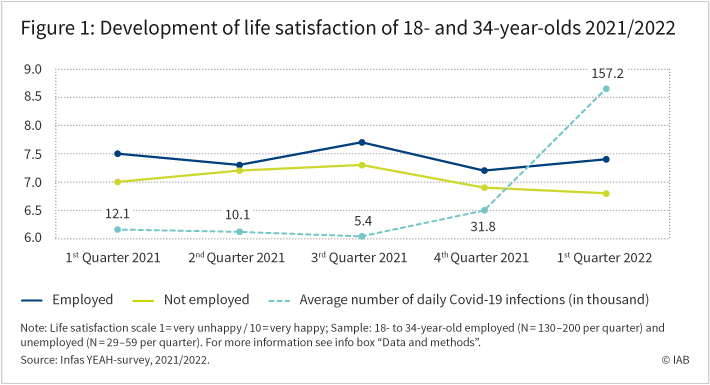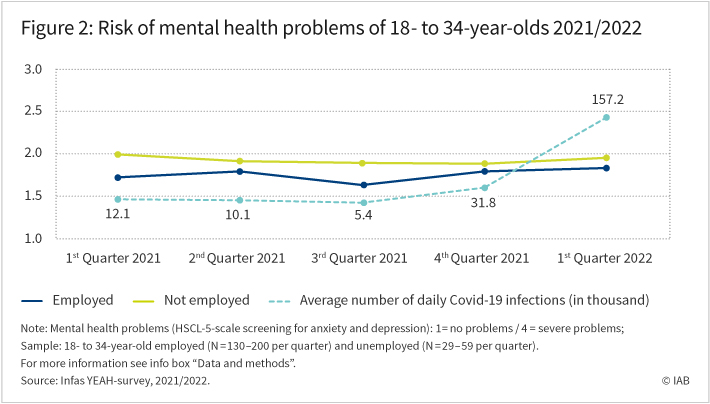15. September 2022 | Series "Tracking youth joblessness during the Covid-19 crisis"
Unemployment and the mental health of young people during the second phase of the Covid-19 pandemic in Germany

The period between the ages of 18 to 34 is decisive for the life course of individuals, because multiple transitions take place involving education, employment and unemployment, or training phases, but also leaving the parental home, partnering and household formation. These transitions typically influence the future development of mental health and vice-versa.
A recent study by Alexander Patzina and others shows that mental health is crucial for successfully finding a first job after training without long job-search periods, retention from apprenticeships or quality of the job. As will be outlined below, the global Covid-19 pandemic, the ensuing economic downturn, as well as associated policy responses (e.g. lockdowns and social distancing measures), led to increases in employment insecurity and to rising mental-health problems and lower life satisfaction. In this context, research indicates that “Covid-19-effects” are most pronounced among young adults compared to middle-aged and older individuals.
The transition into the labour market at the start of their career leaves young people vulnerable to disruptions from crises such as Covid-19. Thus, this particular age group experiences a great amount of uncertainty concerning future educational and labour-market developments, and their future life chances. Within the group of young adults, unemployed individuals constitute a social group which is probably very vulnerable to the Covid-19 pandemic for several reasons. First, the Covid-19 pandemic might lead to a reduction of re-employment opportunities and therefore prolong unemployment periods. Second, unemployment is associated with lower social contact and support – a crucial buffer against adverse mental-health effects. On the other hand, the workplace during the Covid-19 pandemic might itself have induced challenges for employed young adults: the shift towards working from home, sudden changes in daily working routines, a loss of control and fewer connections to the workplace might have been challenging conditions, especially for inexperienced young workers. These factors may, in turn, have led to poorer mental health amongst some young employed individuals.
Against this backdrop, this article argues that a focus on young individuals is important because they are at the beginning of their careers and can participate in working life for many years to come. In the following, the development of life satisfaction and mental-health problems amongst non-employed (including unemployed and inactive individuals) and employed young adults (aged 18 to 34) in Germany is investigated. The time-period spans from 2021 to the first quarter of 2022, covering the second and third period of the Covid-19 pandemic.
Young people’s life satisfaction and mental health in times of Covid-19
Generally, the Covid-19 pandemic has reduced individuals’ life satisfaction and has led to an increase in the number of individuals with mental health issues. In recent years, the importance of mental-health problems and their serious and adverse long-term health implications have increasingly come to the fore. As the Covid-19 pandemic exacerbates insecure life circumstances, it can constitute a shock to mental health. A 2021 study by Jutta Mata et al. shows that after the first lockdown, signs of anxiety, depression, and loneliness have been at particularly high levels in the German.
For Germany, a 2022 study by Sebastian Bähr and co-authors shows a decline in life satisfaction in the initial phase of the Covid-19 pandemic. Thus, in general, the crisis and its consequences have had a negative effect on life satisfaction. This negative initial effect appears to be the same across many social groups. Another 2021 study by Malte Sandner et al. on German high school students and graduates in the transition to post-secondary education suggests that decreases in life satisfaction and mental health are more pronounced among younger individuals.
Life satisfaction of employed compared to non-employed young people
In our study, people were asked to rate their current life satisfaction on a scale of 1 (“very unhappy”) and 10 (“very happy”). The results were mapped against the development of average daily numbers of Covid-19 infections per quarter, which constituted a key indicator for the German Federal Government to decide about infection prevention measures during the pandemic (s. Figure 1). In line with the broad literature on the effects of unemployment on well-being, the answers show that the non-employed were less satisfied with life over the entire observation period. In particular, findings from the first quarter in 2021 indicate pronounced differences between both groups. Over the spring of 2021, life satisfaction of the employed decreased while life satisfaction of the non-employed increased, leading to convergence of the life satisfaction trajectories. Over the Summer and in parallel with declining incidence rates (i.e. during a phase of more relaxed social distancing measures) life satisfaction of young employed people increased again, while life satisfaction of the young non-employed did not change. Interestingly, during the end of 2021, as the next wave of the Covid-19 pandemic hit, the life satisfaction of the employed decreased more strongly, compared to the life satisfaction of the non-employed, leading to a slight convergence of life satisfaction profiles in the autumn/winter of 2021. It is striking that life satisfaction for young employed and young non-employed in the first quarter of 2022 is lower than in the first quarter of 2021.

Mental health problems of employed compared to non-employed young people
Among individuals aged 18 to 34 during 2021, the employed report fewer mental health problems than the non-employed over the entire observation period (s. Figure 2; following the Hopkins Symptom Checklist-5, which screens for indicators of anxiety and depression). Differences in 2021 are most pronounced during the third quarter, potentially due to rising incidence rates, lockdowns, and curfews. In the first quarter of 2021 the average scale value for employed individuals is around 1.7 while the average for unemployed individuals is around 2.1. This indicates that over 50 percent of the non-employed individuals had an increased risk of mental-health problems. Over the spring, when the second, long lockdown in Germany was still in effect, mental-health problems amongst the non-employed decreased, while mental-health problems slightly increased amongst the employed, leading to a convergence of mental health between the two groups. However, over the summer, mental-health problems strongly decreased for young employed individuals, while the level of mental health did not change for the young non- employed. During the third lockdown (fourth quarter of 2021), an increase in mental-health problems can be observed only for employed individuals, whilst the level of mental health did not change for non-employed individuals. A possible explanation might be increasing labour market risks (e.g. short-time work or lay-off fears) of the former group, that might have led to a worsening of peoples’ mental health. Strikingly, the prevalence of mental-health problems among the young employed in the first quarter of 2022 is higher than in the first quarter of 2021, thereby indicating a potential long-term effect of the Covid-19 pandemic within this group of young individuals.

The study results show an almost constant but decreasing risk of mental-health problems (here: anxiety and depression) among non-employed individuals during 2021. A possible explanation might be that the non-employed showed signs of coping over the course of the Covid-19 pandemic. Moreover, mental-health problems among the young non-employed also do not strongly increase during the first quarter in 2022, leading to lower levels of mental health problems in early 2022 among the young non-employed when comparing their levels to the first quarter in 2021.
Conclusion
The life satisfaction and mental health of employed and non-employed young adults during 2021 have developed differently. In general, non-employed young individuals report a lower life satisfaction and more mental health problems over the entire observation period than their employed counterparts. In the beginning of 2021, differences in life satisfaction and mental health between employed and non-employed young adults are most pronounced. The results from the fourth quarter of 2021 and first quarter of 2022 suggest a narrowing of inequality between the employed and non-employed, because employed individuals’ life-satisfaction and mental-health levels responded more negatively to the later Covid-19 wave in Germany. In general, the results of the study suggest that over the entire observation period, employed young adults responded more sensitively to the progression of the Covid-19 pandemic (i.e. infection rates) and unemployed young individuals appeared to be more likely to adopt coping strategies.
The first findings on differences among young adults according to employment status should stimulate future research into the effects of Covid-19 on social inequality in young individuals’ mental health. Moreover, our results suggest that it is very important to distinguish between the different the phases of the progress of the Covid-19 pandemic. In addition, the policy related interventions (distancing, lockdown, masks etc.) related to the pandemic should be considered.
Data & Methods
The analysis uses the Youth Economic Activity and Health (YEAH) special module of the Infas multi-topic survey with repeated cross-sections in 2021 and the beginning of 2022. The data have a total of N=1.100 cases per month overall, and a monthly population in the age range from 18 to 34 years (“Youth”) of N=150. As a measure for mental health, we employ the HSCL-5 scale screening for anxiety and depression; life satisfaction is measured by a single item 11-point Likert scale. The analysis is based on a simple Ordinary-Least-Squares Model with marginal effects displayed. Dummy variables are used, indicating a quarter of the year 2021 and 2022 (to balance sampling effects). Further analysis is aimed at finding a model dealing with auto-correlation or using a pseudo-panel approach.
Literature
Bähr, Sebastian; Frodermann, Corinna; Kohlruss, Julian; Patzina, Alexander; Stegmaier, Jens; Trappmann, Mark (2022): COVID-19, subjective well-being and basic income support in Germany. Zeitschrift für Sozialreform, Vol. 68, No. 1, pp. 85-117.
Dietrich, Hans; Henseke, Golo; Achatz, Juliane; Anger, Silke; Christoph, Bernhard; Patzina, Alexander (2021): Covid-19: how youth unemployment is taking on worrying new patterns. In: UCL Institute of Education BLOG, 05.08.2021.
DiPrete, Thomas A.; Eirich, Gregory M. (2006): Cumulative advantage as a mechanism for inequality: A review of theoretical and empirical developments. Annual review of sociology, pp. 271-297.
Mata, Jutta; Wenz, Alexander; Rettig, Tobias; Reifenscheid, Maximiliane; Möhring, Katja; Krieger, Ulrich; Friedel, Sabine; Fikel Marina; Cornesse Carina; Blom, Anneliese G.; Naumann, Elias (2021): Health behaviors and mental health during the COVID-19 pandemic: A longitudinal population-based survey in Germany. Social Science & Medicine, 287, pp. 114-333:
Möhring, Katja; Naumann, Elias; Reifenscheid, Maximiliane; Wenz, Alexander; Rettig, Tobias; Krieger, Ulrich; Friedel, Sabine; Fikel, Marina; Cornesse Carina; Blom, Anneliese G. (2021): The COVID-19 pandemic and subjective well-being: longitudinal evidence on satisfaction with work and family. European Societies, Vol. 23, pp. 601-617.
Patzina, Alexander; Dietrich, Hans; Barabasch, Anton (2022): Health, Personality Disorders, Work Commitment, and Training-to-Employment Transitions. In: Social Inclusion, Vol. 10, No. 2, pp. 1-14.
Sandner, Malte; Patzina, Alexander; Anger, Silke; Bernhard, Stephan; Dietrich, Hans (2021). The COVID-19 Pandemic, Well-Being, and Transitions to Post-secondary Education. IZA Discussion Paper No. 14797.
Schmidtke, Julia; Hetschko, Clemens; Schöb, Ronnie; Stephan, Gesine; Eid, Michael; Lawes, Mario (2021): The Effects of the Covid-19 Pandemic on the Mental Health and Subjective Wellbeing of Workers: An Event Study Based on High-Frequency Panel Data. IAB-Discussion Paper No. 13.
In short
- We see pronounced changes in life satisfaction and mental health amongst young adults between 18 to 34 years in 2021.
- We find lower well-being levels among non-employed individuals, in particular during the third wave of the Covid-19 pandemic.
- Findings from 2021 suggest a levelling out of inequality between employed and non-employed young adults.
- Non-employed young adults appear more vulnerable, but have also developed strategies to cope with this problem.
- The employed respond more sensitively to the level of Covid-19 infections (and ensuing measures), especially in wave four of the pandemic.
DOI: 10.48720/IAB.FOO.20220915.01
Dietrich, Hans; Patzina, Alexander; Brunner, Laura (2022): Unemployment and the mental health of young people during the second phase of the Covid-19 pandemic in Germany, In: IAB-Forum 15th of September 2022, https://www.iab-forum.de/en/unemployment-and-the-mental-health-of-young-people-during-the-second-phase-of-the-covid-19-pandemic-in-germany/, Retrieved: 19th of April 2024
Authors:
- Hans Dietrich
- Alexander Patzina
- Laura Brunner

 Dr Hans Dietrich is a senior researcher in the department "Education, Training, and Employment Over the Life Course" at the IAB.
Dr Hans Dietrich is a senior researcher in the department "Education, Training, and Employment Over the Life Course" at the IAB. Alexander Patzina is a senior researcher in the research department "Education, Training, and Employment Over the Life Course".
Alexander Patzina is a senior researcher in the research department "Education, Training, and Employment Over the Life Course". Laura Brunner is a student assistant in the department "Education, Training, and Employment over the Life Course" at the IAB.
Laura Brunner is a student assistant in the department "Education, Training, and Employment over the Life Course" at the IAB.